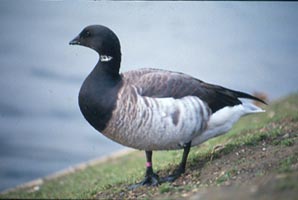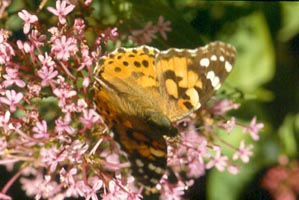Booterstown
Marsh
seems to be constantly improving as a roosting and feeding area for ducks,
waders and gulls. The birdlife in the marsh is counted continuously through
the winter from September to March as part of a nationwide count of waders,
gulls and wildfowl. Members of Birdwatch count along the coast on selected
days each month from September to March and counters on Dublin Bay include
the Marsh on the selected day. Since we began counting in 1999 the number
of birds frequenting the Marsh has improved dramatically. There are probably
a combination of reasons for this. For a long time there was a heavy sediment
of oil beneath the surface of the marsh which would have made it useless
for supporting the worms that waders would be probing the mud for. There
was no sea water coming into the marsh till the channel in from further south
was re-opened and the subsequent tidal flow of salt water probably cleaned
out the polluted soil. In recent counts we have had hundreds of waders roosting
in the safety of the marsh including Redshank, dozens of Black Tailed Godwit
and Dunlin and flocks of Brent Geese.
One very welcome sighting we see there regularly now is that very elegant
wader the Greenshank. A very slim and graceful bird usually seen solitarily
feeding we were delighted when we started seeing one or two of these birds
overwintering in the marsh a few years ago. At our October count this year
we had fifteen of them in the marsh. Another comparatively recent addition
and a very visible one is the Little Egret. Ten years ago these birds would
have been a cause of excitement among birdwatchers as they were very rare
visitors. Now they are breeding in a couple of spots in Ireland and can often
be seen in Booterstown. Like a smaller Heron but snow white with black legs
and yellow feet up to six of them have been seen round the marsh. Less easily
seen is the Kingfisher often just glimpsed as a flash of blue streaking up
the channel. We used often have DART drivers in the station, having seen
us with telescopes, open their window to tell us they had seen the kingfisher
flashing by, as the train passed. Other less visible inhabitants of the marsh
are Snipe and the very elusive Water Rail. Recently An Taisce and some other
concerned groups oversaw the placing of two large mounds of earth in the
marsh which are hoped will become new roosting sites for birds at high tide.
There was also constructed a new viewing area for the marsh at the north
end by the road where you can sit down and have a leisurely look. The hours
before high tide is best time for seeing birds there.
Dun Laoghaire Rathdown County Council are (at the time of writing) in the
process of hiring a Biodiversity Officer. Hopefully we are promised one of
his responsibilities will be the Red Squirrels of Dalkey and Killiney whose
future is at risk from the imminent arrival of Grey Squirrels which are becoming
increasingly common in the area. The Grey is an introduced species and wherever
they move into the native Red Squirrel’s territory it almost always
results in a loss of the Red. Many Greys carry a disease Squirrel Parapox
which they are immune to but is fatal to Reds. Also the Greys are nearly
double the size of Reds and out compete them for food having a much wider
range of food (Greys eat acorns which Reds don’t) as well as the nuts
and seeds the Reds specialise in. UCD are currently carrying out a study
of squirrels in the Phoenix Park which may result in a complete cull of Greys
and reintroduction of Reds. Lets hope our Dalkey squirrels can retain their
foothold, they are lovely little animals and it is a real privilege to share
the neighbourhood with them. The turn of the year often brings a cold spell
and this sometimes brings new species of birds in on to garden feeders. Natural
food such as berries (or even insects in the prolonged mild spells we often
get now in Autumn) may have run out, or some of these birds may have been
gradually making their way south from breeding grounds in northern Europe
to find a regular daily supply of high protein food in suburban gardens.
Family groups of Long tailed Tits, small flocks of Redpoll, Siskins, Greenfinch,
Chaffinch or Goldfinch may start to appear on a regular basis. Birds can
not store much fat or they would become too heavy to fly so they must eat
every day to keep up their energy levels and keep themselves warm at night.
Birds also need water in winter, not just to drink but to preen their feathers.
If their feathers get matted it can impeded their power of flight so on days
when you would not even contemplate the thought of an outdoor swim, you will
often see a bird in your birdbath giving itself a very thorough wash and
shake.
|



